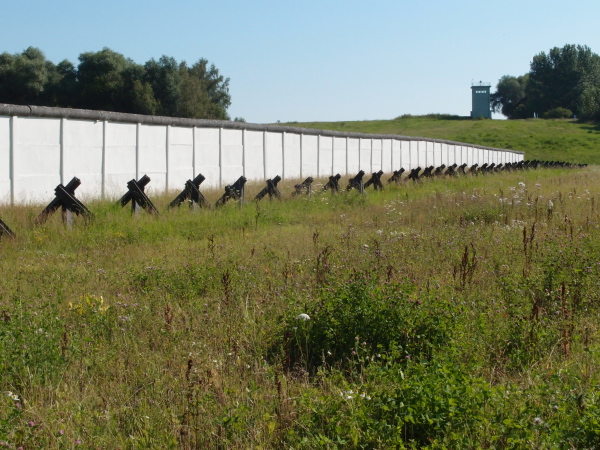 |
| The original wall and watchtower between East and West Germany |
Most
people know about the Berlin Wall. But how many know much about the 1400km wall
that divided families in East and West Germany for a more than a generation?
1400
Kilometers long. A wall right across
Europe. Part of the Iron Curtain. Dividing villages down the main street.
Fences, Watchtowers. Mines. Dogs. Regular armed patrols. More than 1000 people
killed trying to cross from east to west. Until 1989.
 |
| Riding along the old patrol routes |
Now
it is known as the Green Band, an area along much of the wall’s length that is
a haven for plant and animal life. There was so little industrial or
agricultural activity either side of the wall for 50 years that nature
flourished while human activity and relationships shrivelled.
To
cycle along the route of the wall takes you from the Baltic Coast through sandy
flats, over hills and mountains, through forests, between meadows and into
sleeping villages until it reaches the Czech border with Bavaria. This was once
a “dreiländereck” where three countries met in one spot, a quiet patch of
otherwise insignificant woodland.
 |
| Sections of wall remain where they isolated villages and divided communities |
Riding
the length also takes you deep into a tragic period of recent European history.
Illustrating how ideology tore families apart, forced people to abandon their
homes and livelihoods, bankrupted businesses and created an atmosphere of fear
and mistrust.
Cycling
the Deutsch-Deutscher Radweg (the German wall route) on its own or as part of
the Iron Curtain Trail, is a great but sobering experience. It is not a bike
path as such but a route on quiet roads and farm tracks and often along the bumpy
old eastern patrol trials. You will come across watchtowers, sections of wall,
see untold numbers of memorials and signs commemorating the re-opening of
roads, follow the River Elbe and arrive in towns still struggling to return to
prosperity. There are many museums well worth a visit.
Along
the way, close to village of Geisa is point Alpha. Here the American and East
German troops glared at each other across the fence from watchtowers just 150m
apart. In the adjacent museum is a display about the wall, comparing it with
other walls separating peoples:
- · dividing Israel from Palestine in the West Bank
- · the wall which is meant to keep Mexicans out of the USA
- · between North and South Korea
Less
than two years ago, these were the only walls of any significance between
nations and the exhibit indicated that these were as bad as the German wall had
been.
In
Nurnberg the Perimeter Protection Exhibition in January 2016, featured about
100 companies selling all kinds of perimeter protection gadgets, barriers,
gates and equipment designed to keep people out, or in, was busier than ever.
The market is booming as fences are being built across Europe and further
afield – a 1000km fence between Turkmenistan, Afghanistan and Iran was recently
completed.
After
years of cycling around Europe, crossing borders which may appear on a map, but
in fact are invisible and unmarked, pedalling unhindered between countries, how
sad it is to see walls and fences being built between the Schengen countries as a
result of the migrant crisis.
Deutsch
Deutscher Bike Trail
The
Bikeline series of guides is invaluable in helping find the route which is not
well signposted in many places and often difficult to find. Accommodation in
parts is scarce because tourism has not yet returned to this area.
www.esterbauer.com
Schengen
Schengen
is a tiny town at the border of Luxembourg, Germany and France on the River Mosel.
It was here, on a riverboat (there was no building big enough) that the plan
was forged to enable free travel between EU countries. It would be a supreme
irony if border controls were to be introduced here.
The
Mosel is a river with an excellent bike path, great wines all along the route,
and the opportunity to cross borders at will, no questions asked.
 |
| Schengen on the River Mosel, where Luxembourg, Germany and France meet |




No comments:
Post a Comment